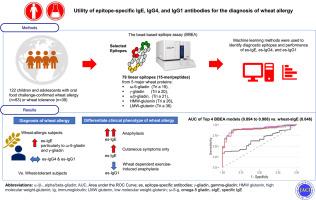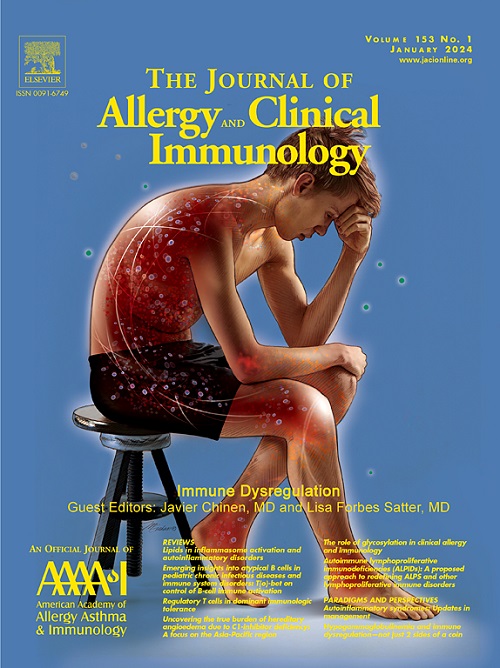表位特异性 IgE、IgG4 和 IgG1 抗体在诊断小麦过敏症中的作用。
IF 11.4
1区 医学
Q1 ALLERGY
引用次数: 0
摘要
背景:基于微珠的表位分析法(BBEA)已被用于鉴定表位特异性(es)抗体,并成功用于诊断临床对牛奶、鸡蛋和花生的过敏:本研究旨在鉴定小麦蛋白中的es-IgE、es-IgG4和es-IgG1,并确定使用BBEA区分小麦过敏者和小麦耐受者的最佳肽:方法:对接受口服食物挑战以确认其小麦过敏状态的儿童和青少年进行登记。从α/β-gliadin、γ-gliadin (γ-gliadin)、ω-5-gliadin (ω-5-gliadin)、高分子量和低分子量谷蛋白中商业化合成了79种肽,并与LumAvidin珠相连接。使用机器学习(ML)方法识别诊断表位,并使用 DeLong 检验评估其性能:分析对象包括 122 名儿童(83 名小麦过敏者和 39 名小麦耐受者,57.4% 为男性)。ML 结合模拟确定了小麦 es-IgE,而不是 es-IgG4 或 es-IgG1 对诊断小麦过敏最有参考价值。较高的 es-IgE 结合强度与过敏表型的严重程度相关,小麦过敏性休克的 es-IgE 结合强度最高。相比之下,小麦依赖性运动诱发过敏性休克(WDEIA)的es-IgG1结合强度低于所有其他组别。来自ω-5-花生蛋白和γ-花生蛋白的一组 4 个信息表位是预测小麦过敏的最佳指标,其 AUC 为 0.908(灵敏度=83.4%,特异性=88.4%),高于小麦特异性 IgE 的表现(AUC=0.646,p < 0.001)。我们的模型的预测能力在一个由 71 名患者(29 名过敏者,42 名非过敏者)组成的外部队列中得到了证实,其 AUC 为 0.908(灵敏度=75.9%,特异性=90.5%):结论:与现有的小麦过敏特异性 IgE 检测相比,小麦 BBEA 的诊断准确性更高。本文章由计算机程序翻译,如有差异,请以英文原文为准。

Utility of epitope-specific IgE, IgG4, and IgG1 antibodies for the diagnosis of wheat allergy
Background
The bead-based epitope assay has been used to identify epitope-specific (es) antibodies and successfully used to diagnose clinical allergy to milk, egg, and peanut.
Objective
We sought to identify es-IgE, es-IgG4, and es-IgG1 of wheat proteins and determine the optimal peptides to differentiate wheat-allergic from wheat-tolerant using the bead-based epitope assay.
Methods
Children and adolescents who underwent an oral food challenge to confirm their wheat allergy status were enrolled. Seventy-nine peptides from α-/β-gliadin, γ-gliadin, ω-5-gliadin, and high- and low-molecular-weight glutenin were commercially synthesized and coupled to LumAvidin beads (Luminex Corporation, Austin, Tex). Machine learning methods were used to identify diagnostic epitopes, and performance was evaluated using the DeLong test.
Results
The analysis included 122 children (83 wheat-allergic and 39 wheat-tolerant; 57.4% male). Machine learning coupled with simulations identified wheat es-IgE, but not es-IgG4 or es-IgG1, to be the most informative for diagnosing wheat allergy. Higher es-IgE binding intensity correlated with the severity of allergy phenotypes, with wheat anaphylaxis exhibiting the highest es-IgE binding intensity. In contrast, wheat-dependent exercise-induced anaphylaxis showed lower es-IgG1 binding intensity than did all the other groups. A set of 4 informative epitopes from ω-5-gliadin and γ-gliadin were the best predictors of wheat allergy, with an area under the curve of 0.908 (sensitivity, 83.4%; specificity, 88.4%), higher than the performance exhibited by wheat-specific IgE (area under the curve = 0.646; P < .001). The predictive ability of our model was confirmed in an external cohort of 71 patients (29 allergic, 42 nonallergic), with an area under the curve of 0.908 (sensitivity, 75.9%; specificity, 90.5%).
Conclusions
The wheat bead-based epitope assay demonstrated greater diagnostic accuracy compared with existing specific IgE tests for wheat allergy.
求助全文
通过发布文献求助,成功后即可免费获取论文全文。
去求助
来源期刊
CiteScore
25.90
自引率
7.70%
发文量
1302
审稿时长
38 days
期刊介绍:
The Journal of Allergy and Clinical Immunology is a prestigious publication that features groundbreaking research in the fields of Allergy, Asthma, and Immunology. This influential journal publishes high-impact research papers that explore various topics, including asthma, food allergy, allergic rhinitis, atopic dermatitis, primary immune deficiencies, occupational and environmental allergy, and other allergic and immunologic diseases. The articles not only report on clinical trials and mechanistic studies but also provide insights into novel therapies, underlying mechanisms, and important discoveries that contribute to our understanding of these diseases. By sharing this valuable information, the journal aims to enhance the diagnosis and management of patients in the future.

 求助内容:
求助内容: 应助结果提醒方式:
应助结果提醒方式:


